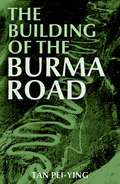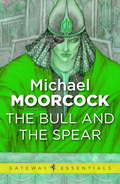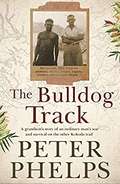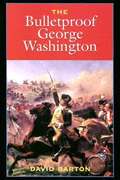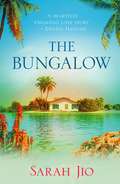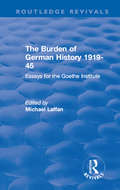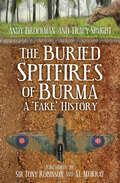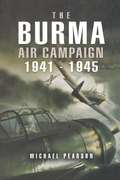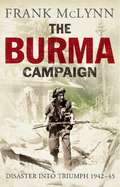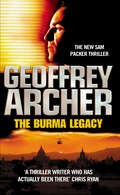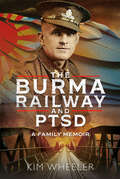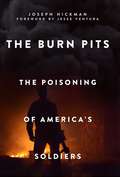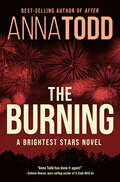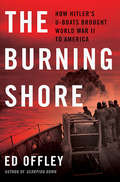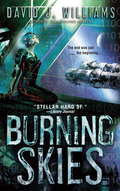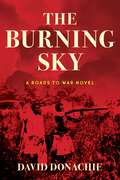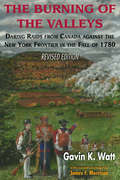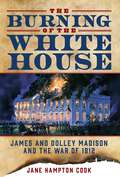- Table View
- List View
The Building of the Burma Road
by Pei-Ying TʻanThe Building of the Burma Road, first published in 1945, is a fascinating firsthand account of the layout and construction of the famous Burma Road by the engineer who was put in charge of the job in 1938. The engrossing story describes the unique combination of native peoples, materials, tools, and machinery used to complete the road, and the extreme challenges faced such as lack of proper equipment, impenetrable rock, malarial swamps, dense jungle, and the outbreak of World War II. Included are 2 maps and 16 pages of illustrations.
The Bulgarian-Byzantine Wars for Early Medieval Balkan Hegemony
by Dennis P. HupchickThis book provides an interpretive narrative of the wars fought by Bulgaria against the Byzantine Empire for dominant control of the Balkan Peninsula during the early medieval era. Over a span of two centuries, from the early ninth through the early eleventh, and under the leadership of the Bulgarian rulers Krum, Simeon I, and Samuil, those conflicts evolved from simple confrontations for territorial possession into a life-or-death struggle for imperial precedence within the Orthodox world then emerging in Eastern Europe—a struggle that the Bulgarians ultimately lost. The primary focus is on Bulgaria, rather than Byzantium, and an effort is made to provide a historically reliable chronology of the assorted campaigns. The various belligerents’ military organizations, defensive technologies, armaments, and tactics are surveyed in an introduction to the main narrative. A prelude chapter sets the stage for the hegemonic conflict, which was divided into three distinct phases by interludes of relative peace between the contending parties, during which Bulgaria’s domestic, foreign, and cultural developments shaped the nature and conduct of the fighting in each successive phase.
The Bull and the Spear: The Eternal Champion (Gateway Essentials #444)
by Michael MoorcockIn an age before time began when the old Gods were abroad in the Earth, Corum of the Scarlet Robe defeated the agents of chaos and cruelty and made history possible. Now a new age requires a hero. There are new lords who would be gods - Odin and Thor and Freya and Loki. And there are the descendants of Corum's Vadagh people, now called Elf-folk.There is a portent - a great black bull sometimes seen on the horizon. The bull must be ridden by the one who possesses the Spear of Llaw Ereint. And the one who will come to possess the spear will be one who has a silver hand - it is the hand of Corum...
The Bulldog Track: A grandson's story of an ordinary man's war and survival on the other Kokoda trail
by Peter PhelpsThis is the story of Tom Phelps and the 'other Kokoda Track'. Seventy-five years later, Tom's grandson, award-winning actor and writer Peter Phelps, is sharing this inspiring tale of resilience and survival.March 1942: The world is at war. Too old to fight and with jobs scarce at home, Tom Phelps found work as a carpenter in the goldfields of the New Guinea Highlands. No one expected the Japanese to attack in the Pacific. But they did.Tom and his mates weren't going to hang around and wait to be killed. With escape routes bombed by the Japanese, their only option was to try to reach safety by foot, through some of the most rugged terrain on Earth - the Bulldog Track.Back home in Sydney, Rose Phelps, their son, George, and three daughters, Joy, Shirley and Ann, waited for news of Tom's fate. George watched the horrors of war unfold on newsreels knowing his dad was 'over there'.Travelling by foot, raft, canoe, schooner, train, luck and courage, Tom Phelps, half-starved and suffering malaria, would eventually make it home. His stories of New Guinea would lead his son and grandson to their own experiences with the country. The Bulldog Track is a grandson's story of an ordinary man's war. It is an incredible tale of survival and the indomitable Aussie spirit.
The Bulldog Track: A grandson's story of an ordinary man's war and survival on the other Kokoda trail
by Peter PhelpsThis is the story of Tom Phelps and the 'other Kokoda Track'. Seventy-five years later, Tom's grandson, award-winning actor and writer Peter Phelps, is sharing this inspiring tale of resilience and survival.March 1942: The world is at war. Too old to fight and with jobs scarce at home, Tom Phelps found work as a carpenter in the goldfields of the New Guinea Highlands. No one expected the Japanese to attack in the Pacific. But they did.Tom and his mates weren't going to hang around and wait to be killed. With escape routes bombed by the Japanese, their only option was to try to reach safety by foot, through some of the most rugged terrain on Earth - the Bulldog Track.Back home in Sydney, Rose Phelps, their son, George, and three daughters, Joy, Shirley and Ann, waited for news of Tom's fate. George watched the horrors of war unfold on newsreels knowing his dad was 'over there'.Travelling by foot, raft, canoe, schooner, train, luck and courage, Tom Phelps, half-starved and suffering malaria, would eventually make it home. His stories of New Guinea would lead his son and grandson to their own experiences with the country. The Bulldog Track is a grandson's story of an ordinary man's war. It is an incredible tale of survival and the indomitable Aussie spirit.
The Bulletproof George Washington (3rd edition)
by David BartonA history of George Washington's battles with the French, English, and the native Indians, from the years 1749-1770. The battle of the Monongahela in 1755 is covered in depth. Includes a timeline and bibliography.
The Bungalow: A Novel (Center Point Premier Romance (large Print) Ser.)
by Sarah JioA sweeping World War II saga of thwarted love, murder, and a long-lost painting.
The Burden of German History 1919-45: Essays for the Goethe Institute (Routledge Revivals)
by Michael LaffanOriginally published in 1988, The Burden of German History 1919-45 examines the vast literature surrounding Weimar years and the National Socialist tragedy, daunting even for the specialist historian or political scientist. The essays included in this volume provide an invaluable guide to research of the time and provides a stimulating review of a wide range of topics in modern German cultural, political, economic and military history. The essays are based on a series of lectures given by German and Irish scholars to a conference on the theme ‘Weimar Germany and National Socialism’, which was held in March 1986 in University College, Dublin, under the auspices of the Goethe Institute, Dublin. This book offers a significant commentary on a period of German history which included the exciting and ambivalent freedom of the Weimar society and the repressive, murderous uniformity of National Socialism.
The Burden of Guilt: How Germany Shattered the Last Days of Peace, Summer 1914
by Daniel Allen ButlerA military historian&’s &“thought-provoking&” examination of Germany&’s role in the outbreak of the First World War (Soldier Magazine). The conflagration that consumed Europe in August 1914 had been a long time in coming—and yet it need never have happened at all. For though all the European powers were prepared to accept a war as a resolution to the tensions which were fermenting across the Continent, only one nation wanted war to come: Imperial Germany. Of all the countries caught up in the tangle of alliances, promises, and pledges of support during the crisis that followed the assassination of Archduke Franz Ferdinand, Germany alone possessed the opportunity and the power to determine that a war in eastern Europe would become the Great War, which swept across the Continent and nearly destroyed a thousand years of European civilization. For nearly nine decades it has been argued that the responsibility for the First World War was a shared one, spread among all the Great Powers. Now, in The Burden of Guilt, historian Daniel Allen Butler substantively challenges that point of view, establishing that the Treaty of Versailles was actually a correct and fair judgment: Germany did indeed bear the true responsibility for the Great War. Working from government archives and records, as well as personal papers and memoirs of the men who made the decisions that carried Europe to war, Butler interweaves the events of summer 1914 with portraits of the monarchs, diplomats, prime ministers, and other national leaders involved in the crisis. He explores the national policies and goals these men were pursuing, and shows conclusively how on three distinct occasions the Imperial German government was presented with opportunities to contain the spreading crisis—opportunities unlike those of any other nation involved—yet each time, the German government consciously and deliberately chose the path which virtually assured that the Continent would go up in flames. The Burden of Guilt is a work destined to become an essential part of the library of the First World War, vital to understanding not only the &“how&” but also the &“why&” behind the pivotal event of modern world history.
The Burden-Sharing Dilemma: Coercive Diplomacy in US Alliance Politics (Cornell Studies in Security Affairs)
by Brian D. BlankenshipThe Burden-Sharing Dilemma examines the conditions under which the United States is willing and able to pressure its allies to assume more responsibility for their own defense. The United States has a mixed track record of encouraging allied burden-sharing—while it has succeeded or failed in some cases, it has declined to do so at all in others. This variation, Brian D. Blankenship argues, is because the United States tailors its burden-sharing pressure in accordance with two competing priorities: conserving its own resources and preserving influence in its alliances. Although burden-sharing enables great power patrons like the United States to lower alliance costs, it also empowers allies to resist patron influence. Blankenship identifies three factors that determine the severity of this burden-sharing dilemma and how it is managed: the latent military power of allies, the shared external threat environment, and the level of a patron's resource constraints. Through case studies of US alliances formed during the Cold War, he shows that a patron can mitigate the dilemma by combining assurances of protection with threats of abandonment and by exercising discretion in its burden-sharing pressure. Blankenship's findings dismantle assumptions that burden-sharing is always desirable but difficult to obtain. Patrons, as the book reveals, can in fact be reluctant to seek burden-sharing, and attempts to pass defense costs to allies can often be successful. At a time when skepticism of alliance benefits remains high and global power shifts threaten longstanding pacts, The Burden-Sharing Dilemma recalls and reconceives the value of burden-sharing and alliances.
The Buried Spitfires of Burma: A ‘Fake’ History
by Tony Robinson Al Murray Andy Brockman Tracy SpaightRumours of buried Spitfires from the Second World War have spread around the world for seventy-five years, fuelling dreams of treasure hunting and watching the iconic aircraft fly again. In April 2012, the press reported that British Prime Minister David Cameron had negotiated an agreement with Myanmar President Thein Sein for the recovery and repatriation of twenty crated Spitfires, reportedly buried at RAF Mingaladon, Yangon, after the Second World War. Astonishingly the agreement came about through the single-minded determination of an ordinary Lincolnshire farmer, David Cundall. After months of negotiation, in January 2013 the excavation begins. Armed with a high-tech survey showing mysterious shapes under the sun-baked surface of Yangon International Airport, David’s expedition is equipped with state-of-the-art JCB excavators, led by a team of archaeologists, and supported by Wargaming.net. Nothing can stop him from recovering the iconic aircraft because, as David tells the world’s media, ‘it’s impossible to make up this story’. But instead of Spitfires, the team unearths a tale of fake history, highlighting the conflict between those want to believe legends and those who demand evidence and the truth. The Buried Spitfires of Burma explores what happened next as David Cundall’s dream unravelled over the course of a historical ‘whodunnit’ that spans seven decades and three continents. In so doing, it follows one of the most bizarre, colourful, and off-the-wall stories since the sensational Hitler Diaries hoax astonished the world in 1983.
The Burma Air Campaign, 1941–1945: 1941-1945
by Michael PearsonThe scene is set with an overview of the respective states of the RAF and Japanese Airforce, and an explanation of how the American Volunteer Group (The Flying Tigers) came to be in China. There is a concise description of air ops covering the Japanese invasion of Indo China, Malaya and Singapore, together with a close study of the sinking of the Prince of Wales and Repulse, which altered the air/sea power equation. The main emphasis is on the use of air power both offensive, defensive and air transport during the protracted Burma Campaign. This embraces operations in the Arakan and the various Chindit long range penetration expeditions. These relied almost totally on air supply and evacuation. In the later stages of the War, the US and RAF combined forces and predictably this was not without controversy. Few realize that US B29s operating from India attacked Japan itself. Finally the role of ground attack aircraft against the retreating Japanese played a significant part in the Allied advance in Burma.
The Burma Campaign: Disaster Into Triumph, 1942 – 45 (The Yale Library of Military History)
by Frank McLynnThis history reveals the failures and fortunes of leadership during the WWII campaign into Japanese-occupied Burma: &“a thoroughly satisfying experience&” (Kirkus). Acclaimed historian Frank McLynn tells the story of four larger-than-life Allied commanders whose lives collided in the Burma campaign, one of the most punishing and protracted military adventures of World War II. This vivid account ranges from Britain&’s defeat in 1942 through the crucial battles of Imphal and Kohima—known as "the Stalingrad of the East"—and on to ultimate victory in 1945. Frank McLynn narrative focuses on the interactions and antagonisms of its principal players: William Slim, the brilliant general; Orde Wingate, the idiosyncratic commander of a British force of irregulars; Louis Mountbatten, one of Churchill's favorites, overpromoted to the position of Supreme Commander, S.E. Asia; and Joseph "Vinegar Joe" Stilwell, a hard-line—and openly anlgophobic—U.S. general. With lively portraits of each of these men, McLynn shows how the plans and strategies of generals and politicians were translated into a hideous reality for soldiers on the ground.
The Burma Legacy
by Geoffrey ArcherSam Packer, hero of Firehawk and The Lucifer Network, has a new assignment that will combine all his diplomatic and survival skills. An aging, wealthy Japanese businessman, Tetsuo Kamata, wants to rescue an ailing British car company, but the moment the announcement is made, death threats are made against Kamata by a former prisoner-of -war, Peregrine Harrison, who was tortured on the infamous Burma Railway. For the last five decades, Harrison has been the leader of a British-based cult. Packer can't believe that at the age of 77 Harrison has the strength or will to exact revenge, but he reckons without Harrison's cult adherents, one of whom is a ruthless ex-SAS operative now involved in drug smuggling in the Burma triangle. Packer learns that Kamata will be hit while visiting a new factory site in Burma and is flown out under cover to prevent a tragedy. Kamata is kidnapped and Packer is soon in the jungle, both hunter and hunted as he searches for the missing man and is tracked by his enemies. The Burma Legacy combines Geoffrey Archer's immaculate research with heart stopping action.
The Burma Railway and PTSD: A Family Memoir
by Kim WheelerMany books and memoirs have been written on prisoner of war captivity in the Far East during the Second World War. Some contain incredible detail concerning the fall of Singapore and are full of military historical facts. This book is not like that. Instead, it is written from the viewpoint of a young girl who experienced the bittersweet homecoming of her traumatized father, Jack, following the end of the war. June and her mother, Beatrice, had lovingly prepared for Jack’s long-awaited return from his imprisonment at the hands of the Japanese out in the Far East. June recounts that they quickly realized how ill-prepared they were to deal with Jack’s post-war traumas. The man who returned home did not resemble the man who had left in 1941. It proved to be a troubled journey as they navigated a path back to a semblance of normal family life. Their only way to cut through Jack’s decompression from three and a half years of intensely cruel mental stress in the notorious POW camps was by exercising incredible patience and, ultimately, talking it through with brutal honesty. Jack was not a man who would have sought out help, especially concerning how he felt inside. Today, we comfortably talk about mental health and, in Jack’s case, PTSD. Following recent conflicts across the world, the topic of mental suffering has been thrown wide open. It has become part of our everyday language and is viewed with compassion. There is no shame in any type of mental health issue. However, June admitted that thirty years ago she would have been nervous to put her story down on paper. We are now acutely aware of what those unfortunate returning prisoners of war were suffering back in 1945. There is no shame to call out what it was – Post-Traumatic Stress Disorder (PTSD). This was a psychological trauma gained in horrific circumstances. Invisible injuries that became imprinted on minds. The military and government put the traumatized returning prisoners of war under immense pressure not to speak of their experiences in captivity. Sadly, many of them took the instruction seriously and never discussed it with their families or friends. The message that had been conveyed was that they were nothing more than an embarrassing inconvenience. Jack recalled how they were told Britain was over the war and that people were moving on with their lives. No one would be interested in their tales of horror and, indeed, they may not even have believed them. Jack told us they were given leaflets concerning the matter on board their repatriation ships as they sailed homewards. Those returning POWs had already been dubbed The Forgotten Army, and then they were told to just disappear into society without recognition.
The Burn Pits: The Poisoning of America's Soldiers
by Joseph Hickman“There’s a whole chapter on my son Beau… He was co-located [twice] near these burn pits.”–Joe Biden, former Vice President of the United States of AmericaThe Agent Orange of the 21st Century… Thousands of American soldiers are returning from the battlefields of Iraq and Afghanistan with severe wounds from chemical war. They are not the victims of ruthless enemy warfare, but of their own military commanders. These soldiers, afflicted with rare cancers and respiratory diseases, were sickened from the smoke and ash swirling out of the “burn pits” where military contractors incinerated mountains of trash, including old stockpiles of mustard and sarin gas, medical waste, and other toxic material.This shocking work, now for the first time in paperback, includes: Illustration of the devastation in one soldier’s intimate story A plea for help Connection between the burn pits and Major Biden’s unfortunate suffering and death The burn pits’ effects on native citizens of Iraq: mothers, fathers, and children Denial from the Department of Defense and others Warning signs that were ignored and much moreBased on thousands of government documents, over five hundred in-depth medical case studies, and interviews with more than one thousand veterans and active-duty GIs, The Burn Pits will shock the nation. The book is more than an explosive work of investigative journalism—it is the deeply moving chronicle of the many young men and women who signed up to serve their country in the wake of 9/11, only to return home permanently damaged, the victims of their own armed forces’ criminal negligence.
The Burning
by Anna ToddA bond this strong can’t stay broken.Life near the army base at Fort Benning, Georgia, might be small, but it’s safe. That suits Karina Fischer just fine. She knows letting anyone get close to her means she could get hurt, and she’s had enough of that in her almost twenty-one years to last a lifetime. The only man she’s ever let in, Kael Martin, betrayed her trust before they could find their way together. She can’t forgive him for what he’s done, but letting go still feels impossible.Kael Martin’s scars run deep, but the mark Karina left on him is deeper. He can’t get her out of his mind or his heart. He’s ready to start fresh, adjust to civilian life, and build a future outside of the Army—one he hopes could include Karina, because their spark, while it burned, was unforgettable.Now, just when it seems their world is crumbling and can’t be put back together, circumstances force them to confront what they can’t deny: the volatile, passionate, all-consuming love they can’t live without.Karina and Kael's unlikely love story, which began in THE FALLING, grows deeper and even more intense in THE BURNING, the second book in the Brightest Stars trilogy.
The Burning Land: A Novel (Saxon Tales #5)
by Bernard CornwellThe fifth installment of Bernard Cornwell’s New York Times bestselling Saxon Tales chronicling the epic saga of the making of England, “like Game of Thrones, but real” (The Observer, London)—the basis for The Last Kingdom, the hit television series.At the end of the ninth century, with King Alfred of Wessex in ill health and his heir still an untested youth, it falls to Alfred’s reluctant warlord Uhtred to outwit and outbattle the invading enemy Danes, led by the sword of savage warrior Harald Bloodhair. But the sweetness of Uhtred’s victory is soured by tragedy, forcing him to break with the Saxon king. Joining the Vikings, allied with his old friend Ragnar—and his old foe Haesten—Uhtred devises a strategy to invade and conquer Wessex itself. But fate has very different plans. Bernard Cornwell’s The Burning Land is an irresistible new chapter in his epic story of the birth of England and the legendary king who made it possible.
The Burning Light
by Rob Ziegler Bradley P. BeaulieuDisgraced government operative Colonel Chu is exiled to the flooded relic of New York City. Something called the Light has hit the streets like an epidemic, leavings its users strung out and disconnected from the mind-network humanity relies on. Chu has lost everything she cares about to the Light. She'll end the threat or die trying.A former corporate pilot who controlled a thousand ships with her mind, Zola looks like just another Light-junkie living hand to mouth on the edge of society. She's special though. As much as she needs the Light, the Light needs her too. But, Chu is getting close and Zola can't hide forever.The Burning Light is a thrilling and all-too believable science fiction novella from Bradley P. Beaulieu and Rob Ziegler, the authors of Twelve Kings in Sharakhai and Seed.At the Publisher's request, this title is being sold without Digital Rights Management Software (DRM) applied.
The Burning Shore: How Hitler's U-Boats Brought World War II to America
by Ed OffleyThe untold story of two men-an American pilot and a German U-boat commander-whose clash off the coast of North Carolina brought the horrors of World War II to American shores
The Burning Skies (Autumn Rain #2)
by David J. WilliamsLife as U.S. counterintelligence agent Claire Haskell once knew it is in tatters--her mission betrayed, her lover dead, and her memories of the past suspect. Worse, the defeat of the mysterious insurgent group known as Autumn Rain was not as complete as many believed. It is quickly becoming clear that the group's ultimate goal is not simply to destroy the tenuous global alliances of the 22nd century-- but to rule all of humanity. And they're starting with the violent destruction of the Net and the assassination of the U.S. president. Now it's up to Claire, with her ability to jack her brain into the systems of the enemy, to win this impossible war. Battling ferociously across the Earth-Moon system, and navigating a complex world filled with both steadfast loyalists and ruthless traitors, Claire must be ready for the Rain's next move. But the true enemy may already be one step ahead of her.
The Burning Sky: A Roads to War Novel (Roads to War)
by David DonachieThe first installment in Donachie's sweeping Roads to War series set in the pre-WWII European powder keg1935: Cal Jardine is a soldier of fortune. Forced to leave Hamburg where he has been helping Jews flee the Nazis, he is recruited by a secretive British committee to smuggle guns to Abyssinia, a country threatened by Italian invasion. But first Jardine must procure the weapons from Rumania, a country full of treacherous locals as well as German agents seeking his arrest. By sleight of hand, he contrives to steal the weapons he wanted to buy before escaping the country, leaving both the Rumanians and Germans floundering. Taken to the Horn of Africa, the arms are then transported over a harsh landscape, along an old slave trader&’s route full of danger, and into the hands of the Ethiopian Army.On his travels, Jardine acquires more baggage than he anticipated—including a beautiful but difficult American woman in search of her archaeologist mother, a determined reporter, and a daredevil French flyer—and avoids a painful death by sheer good fortune. But the Ethiopians are ill-equipped to face a modern Italian army using tanks, bombers, and poison gas. Trained for war, can Jardine simply walk away, or will he be drawn into a bloody conflict against massive odds? And can he manage to save those who now depend on him?
The Burning of Moscow: Napoleon's Trail By Fire, 1812
by Alexander MikaberidzeAs soon as Napoleon and his Grand Army entered Moscow, on 14 September 1812, the capital erupted in flames that eventually engulfed and destroyed two thirds of the city. The fiery devastation had a profound effect on the Grand Army, but for thirty-five days Napoleon stayed, making increasingly desperate efforts to achieve peace with Russia. Then, in October, almost surrounded by the Russians and with winter fast approaching, he abandoned the capital and embarked on the long, bitter retreat that destroyed his army. The month-long stay in Moscow was a pivotal moment in the war of 1812 the moment when the initiative swung towards the Tsar's armies and spelled doom for the invading Grand Army yet it has rarely been studied in the same depth as the other key events of the campaign.Alexander Mikaberidze, in this third volume of his in-depth reassessment of the war between the French and Russian empires, emphasizes the importance of the Moscow fire and shows how Russian intransigence sealed the fate of the French army. He uses a vast array of French, German, Polish and Russian memoirs, letters and diaries as well as archival material in order to tell the dramatic story of the Moscow fire. Not only does he provide a comprehensive account of events, looking at them from both the French and Russian points of view, but he explores the Russians' motives for leaving, then burning their capital. Using extensive eyewitness accounts, he paints a vivid picture of the harsh reality of life in the remains of the occupied city and describes military operations around Moscow at this turning point in the campaign.
The Burning of the Valleys: Daring Raids from Canada Against the New York Frontier in the Fall of 1780
by Gavin K. WattIn the fifth year of the War of Independence, while the Americans focused on the British thrust against the Carolinas, the Canadian Department waged a decisive campaign against the northern frontier of New York. Their primary target was the Mohawk River region, known to be the "grainbowl" that fed Washington’s armies. The Burning of the Valleys details the actions of both sides in this exciting and incredibly effective British campaign. General Frederick Haldimand of Canada possessed a potent force, formed by the deadly alliance of toughened, embittered Tories, who had abandoned their families and farms in New York and Pennsylvania to join the King’s Provincial regiments in Canada, and the enraged Six Nations Iroquois, whose towns and farmlands had been utterly devastated by Continentals in 1779. The Governor augmented this highly motivated force with British and German regulars and Canadian Iroquois. In October, without benefit of modern transportation, communications or navigational aids, four coordinated raids, each thoroughly examined in this book, penetrated deeply into American territory. The raiders fought skirmishes and battles, took hundreds of prisoners, burned forts, farms, and mills and destroyed one of the finest grain harvests in living memory.
The Burning of the White House: James and Dolley Madison and the War of 1812
by Jane Hampton CookIt's unimaginable today, even for a generation that saw the Twin Towers fall and the Pentagon attacked. It's unimaginable because in 1814 enemies didn't fly overhead, they marched through the streets; and for 26 hours in August, the British enemy marched through Washington, D.C. and set fire to government buildings, including the U.S. Capitol and the White House.Relying on first-hand accounts, historian Jane Hampton Cook weaves together several different narratives to create a vivid, multidimensional account of the burning of Washington, including the escalation that led to it and the immediate aftermath. From James and Dolley Madison to the British admiral who ordered the White House set aflame, historical figures are brought to life through their experience of this unprecedented attack. The Burning of the White House is the story of a city invaded, a presidential family displaced, a nation humbled, and an American spirit that somehow remained unbroken.
